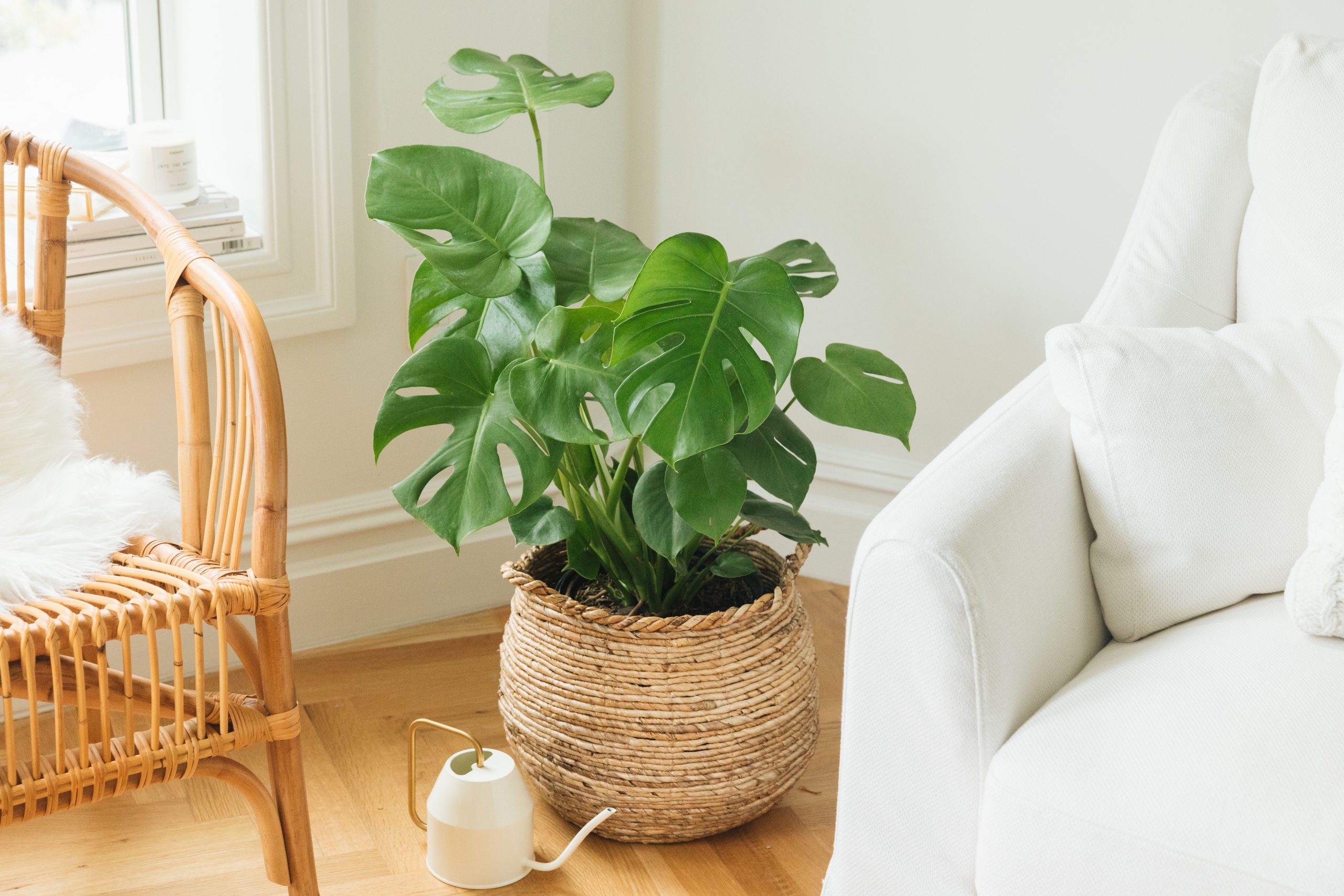How to Grow and Care for Monstera Deliciosa
Belonging to the rain forests of Central America, the vast, vigorous Monstera deliciosa plant is likewise referred to as the “split-leaf philodendron.” This easy-to-grow climbing-up evergreen can be discovered in numerous developer areas for its “wow” aspect.
Inside, the plant has a modest development price and can expand in elevation of 1 to 2 feet a year. Its usually shiny big heart-shaped fallen leaves have a particular split. You’ll likewise identify complex airborne origins outgrowing the dirt, which profit the plant by sustaining the stems that hold leaves that can expand to 3 feet long.

Plant outdoors in the ideal area any time throughout the year. It will also create tannish-cream blossoms cross-pollinated by edible juicy fruit with the consolidated taste of pineapple and banana. Nonetheless, fruiting is not typical in houseplants. This lovely plant can be poisonous to animals.
| Common Names | Split-leaf philodendron, Swiss cheese plant, window leaf, ceriman |
| Botanical Name | delicious monstera |
| Family | Araceae |
| Plant Type | Climbing evergreen |
| Mature Size | 3 ft. tall, 2-3 ft. spread |
| Sun Exposure | Bright indirect sunlight, partial shade |
| Soil Type | Peat-based potting soil, well-drained |
| Soil pH | Acid or neutral |
| Bloom Time | Mid-summer |
| Flower Color | Cream/tan |
| Hardiness Zones | 10-12 (USDA) |
| Native Area | Central America |
| Toxicity | Toxic to cats and dogs |
Monstera Deliciosa Care
Hardy in USDA Zones 10 via 12, Monstera deliciosa prospers year-round in cozy, moist weather conditions. When growing outdoors, develop it in part-shade in well-draining dirt. If the ground is usually salted in your area, relocate to the patio or inside.
Use a well-balanced plant food 3 or 4 times a year, and the plant might expand 10 feet high or much more. If it’s planned as a houseplant, pick a deep pot with several drain openings.
Light
This evergreen prefers bright, indirect sunlight in temperatures between 65 and 75 degrees Fahrenheit. Too much direct light in warmer months may burn the foliage. Still, set indoor plants outside at least once a year in direct sunlight to encourage lush growth.
Outdoors, the Swiss cheese plant can grow in the full shade of deep woodlands and semi-shade of light forests.
Soil
When established in a container, it requires peat-based potting media. Outdoors it is suitable for light sandy, medium loamy, and heavy clay soils with acid or neutral pH. Even so, it thrives most in well-drained, moderately moist soil.
Water
Give the plant regular watering during the growing season every one to two weeks. Water until the excess drains through drainage holes. Please do not put the excess water back into the plant’s container because it has taken all the water it needs.
The soil will need to dry out slightly in between waterings. Water only occasionally in fall and winter. To increase humidity indoors, mist the foliage using a spray bottle of demineralized water or rainwater.
Fertilizer
Choose a balanced liquid 20-20-20 fertilizer to feed the plant every few weeks during the growing season. Dilute 1/2 teaspoon of the fertilizer in a gallon of water. Use the diluted fertilizer in place of regular watering. Pour the mixture into the soil until it flows out of the drainage holes. Throw out the excess diluted fertilizer because the plant has taken what it needs and cannot use the extra that it drains off.
Pruning
Trim aerial roots if they get too unruly for the space, though tucking them back into the pot is preferred. Unlike some other houseplants, their roots do not damage surfaces. Stems and leaves respond well to trimming and can be used for propagation.
Propagating Monstera Deliciosa
Monstera deliciosa can be easily propagated by stem cuttings from pruning. However, the most popular method of propagating Monstera deliciosa is air layering. Here are the steps for both ways:
To increase with stem cuttings
Using a clean, sharp trimming shear, removed a stem consisting of a node (a little bump, which is where the origins will undoubtedly arise), an airborne source, and at the very least 2 fallen leaves.
Place a dashboard of ground cinnamon (the common seasoning you can access at the supermarket) on the mom plant where you made it. This will certainly stop any condition from going into the cut and aid the injury recovery.
Place the cutting in a glass of water. Modify the water every 3 to 5 days, and also, when possible, utilize filtered water or rain over faucet water.
You will undoubtedly see a glob of origins expanding in several months. Then, you can place your brand-new plant in a pot with fresh dirt and maintain it damp as it develops in its brand-new residence.
To multiply with air layering
Air layering is a recommended low-risk approach since you’re not cutting the mommy plant until the child prepares to be placed in a pot with brand-new origins. The mom plant might not look eye-catching for some time, yet obtaining a healthy and balanced brand-new plant is worth it. For this approach, you’ll require flower or sphagnum moss, a plastic bag or cling wrap, and spin connections.
Discover a stem with several nodes (where the origins will certainly expand). Or, locate a fallen leave that is outgrowing a branch and also has a brief airborne source listed below it.
Cut a little notch concerning 1/3 of the stem’s size, listed below that origin.
Cover a 1-inch layer of sphagnum moss around the factor where the fallen leave a sign up with the stem.
Splash the moss with water to enhance wetness and cover it in plastic. Usage spin connections to safeguard it (it might look a little unpleasant, which is all right).
Make sure the moss can stay damp till the origins establish.
When origins establish in a couple of months, you can reduce (with a tidy, sharp device) the stem listed below the roots and develop the young plant, with its origins, in a fresh pot of dirt.
Do not fail to remember to rub ground cinnamon on the injury developed on the mommy plant. This will certainly prevent any condition from getting in the cut and assist the recovery of the damage.
Potting and Repotting Monstera Deliciosa
Every 2 years, approximately, the Swiss cheese plant will likely outgrow its pot. Transplant right into a pool a couple of inches broader and much deeper to fit development. This plant chooses well-draining permeable pots, such as terracotta or clay, because they include air movement and water drainage. Nonetheless, any product pot with water drainage openings will undoubtedly do. Bank the plant by making use of these straightforward actions:
Fill the lower 3rd of a pot with peaty potting dirt.
Develop a risk carefully for the stem to get on.
Establish the origins right into the container. Full of dirt around the heads.
Securely border the risk with dirt and use plant connections to affix the stem to the risk.
Common Pests
Cleaning dirt or particles off fallen leaves with a wet sponge or paper towel will undoubtedly maintain the plant tidy and avoid parasites. Nonetheless, typical parasites that can get into the plant consist of mealybugs, aphids, thrips, range, and crawler termites.
If any are discovered on the vegetation, spray the plant with a straight water stream. Leaves can likewise be cleaned with insecticidal soap.
Common Problems of Monstera Deliciosa
Though it’s a relatively carefree houseplant, the Swiss cheese plant can trigger a couple of migraines. Once you identify why your plant looks a little sickly, it can recoup well.
Browning Tips
If the pointers of the fallen leaves are transforming brownish, that typically indicates the dirt might be dried, or you must regularly sprinkle the plant on a routine to maintain it damp. Eliminate the afflicted fallen leaves.
If there’s a yellow halo around the brownish places or ideas, that suggests your plant has gotten a fungus. The fungi most likely arrived due to overwatering or maintaining the plant in extremely damp dirt for as well lengthy. Eliminate the damaged fallen leaves and allow the plant to dry a little before sprinkling.
Yellow Leaves
Yellowing fallen leaves is a sign of dried dirt. The earliest leaves on the plant will undoubtedly transform yellow initially. Eliminate the afflicted fallen leaves. Inspect the ground as well as if it’s bone scorched, offering it an excellent watering.
Wilting Leaves
If you see wilting fallen leaves, there’s a sprinkling problem, also. The plant is either overwatered or underwatered. If it’s overwatered, the plant can experience origin rot. Attempt taking the plant out of the pot to examine its origins. Tidy the roots up, trim off mushy components, and also report in brand-new dirt.
Answer questions when performing
Is Monstera deliciosa simple to take care of?
As a houseplant, this plant is simple to expand and preserve. Outdoors, you must stay in the best cozy and moist setting for it to grow.
Why do the fallen leaves on some Monstera deliciosa plants divide more than others?
Fenestrated fallen leaves call for a great deal of power to divide. The even more light the plant obtains, the extra it will certainly divide. Much less light generates smaller-sized, much less flashy fallen leaves.
What is the distinction between Monstera deliciosa and also Monstera adansonii?
Both monstera plants are called Swiss cheese plants; however, the dimension of their fallen leaves varies. Monstera deliciosa’s fallen leaves are considerably more significant than the small fallen leaves of Monstera adansonii.
Last, Uint. co sent you details about the topic “How to Grow and Care for Monstera Deliciosa❤️️. ” We hope with helpful information that the article “How to Grow and Care for Monstera Deliciosa” will help readers to be more interested in “How to Grow and Care for Monstera Deliciosa [ ❤️️❤️️ ].”
“How to Grow and Care for Monstera Deliciosa” posted on 2020-07-29 20:34:at 34. Thank you for reading the article at Uint. Co – The Latest News Technology, Finance, Banking.
